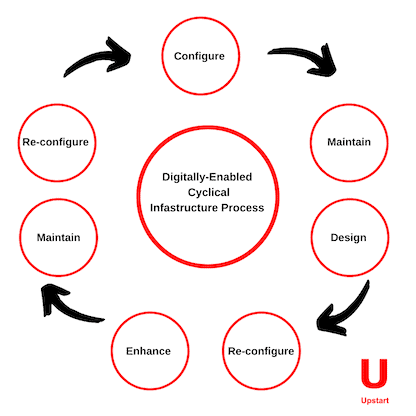Technology as a disruptive force is changing industries, business models and livelihoods. The $3bn+ global infrastructure market - and its supply chain - may be next to feel these effects.
Upstart has teamed up with Interimconsult to explore how digital disruption may affect some of the UK’s largest infrastructure projects and their supply chains, including those in the rail sector.
So?
Cost overruns and late delivery are well-known problems blighting infrastructure projects. The current headlines on large programmes such as HS2 and Crossrail only serve to illustrate that change is essential as we head into the third decade of the 21st Century. These structural inefficiencies look very much like those which made media, telcos, financial services and health a series ripe for disruption.
Is the industry ready for change?
There are moves to address these problems head on. In the UK, the Institute of Civil Engineers (ICE) recently published a report on reducing the gap between cost estimates and outturns for major infrastructure projects and programmes. It recommended that:
- infrastructure owners should complete scope, design and exploration before starting work through Early Contractor Involvement
- project managers should move away from capital cost as the most important metric when assessing project benefits, recognising the importance of whole-life economic, social and environmental value
- infrastructure owners should undertake cost modelling to help achieve realistic tender prices during the procurement process
- infrastructure owners should undertake procurement to award contracts based on a cost estimate range, using a “should-cost” and contingency spread estimate based on the level of project maturity.
These recommendations, if adopted, should help reduce costs and close the estimate-outturn gap. Initiatives such as early contractor involvement can provide benefits but, in essence, this is only incremental change - it’s about doing what we do today a little better through better scoping, design, planning and execution – delivering today’s equivalent of Henry Ford’s “faster horses” rather than the cars which were needed.
Surprisingly the ICE report only refers to technology twice; as a means of improving estimation, and that there is an increased risk of introducing new technology in the absence of standards.
The omission of any reference to the benefits and savings from technological innovations shows an unconscious bias towards incremental change to current practice, rather than tech-led opportunities to improve planning, reduce completion time or cost.
So What?
This unconscious bias may lead to customers and suppliers missing out on game-changing future opportunities arising from emerging disruptive technologies.

Thankfully, however, the infrastructure industry is not completely without technological innovation. The HS2 rail project has recognised the importance of introducing new technologies ‘in-flight’ to achieve successful delivery; their HS2 Innovation Accelerator programme has identified five UK companies to pitch innovative solutions to the HS2 supply chain. Similar initiatives are occurring throughout the rail industry, with frequent calls for innovative proposals by Network Rail, Innovate UK and the Rail Safety and Standards Board.
Introducing what is often SME and micro-business led innovation to the industry through calls for supplier-led proposals is commonplace. Ideas are ‘pushed’ upwards by a supply chain looking to provide solutions to address high-profile customer and industry challenges; decarbonisation, productivity and skills development are just some examples. These programmes are welcome, but investment and capital constraints mean suppliers often work through a narrow lens that limits the solutions they can offer and their impact on the industry.
What if buyers had access to supplier-independent early warning systems highlighting the hidden disruptive technologies liable to displace or radically change infrastructure programme delivery? These early-warning systems could help identify disruptive innovations from other sectors and worldwide markets.
Customers could themselves seek out providers of new technologies, ‘pulling’ innovations, from suppliers, maybe from alternative markets, that address long standing challenges. Or, using the same approach, suppliers could identify opportunities using their own disruptive technology, providing them with a competitive commercial edge when entering a market for the first time.
So Now What?
Money talks, and despite the current COVID-19-related problems, the infrastructure sector is undeniably a commercially attractive one to market entrants offering disruptive technologies. Many of the innovations and innovators we’re likely to see entering into the rail sector may come from global tech players in other markets, not just tech start-ups and SMEs. This is already true in disrupted industries, where Google, Apple, Microsoft, Amazon and others such as IBM are part of the landscape.
Traditional infrastructure solutions and practices will almost certainly be displaced in some way.
The influence of tech may give the infrastructure sector an opportunity to move from the traditional non-digital linear systems delivery model:

to a digitally-enabled cyclical infrastructure process that might comprise constant reconfiguring of assets based on future needs.

Using this language alone can help promote a mindset shift and provide a new perspective on what might be possible. Infrastructure design for a “configuration and reconfiguration” system lifecycle is a different challenge from the traditional design, build, maintenance and operation cycle. This would also embolden both clients and suppliers to become more agile and receptive to the integration of disruptive technologies.
To prepare for disruption and seize its opportunities, organisations in infrastructure can:
- obtain insight into the opportunities yielded by disruptive technology; both within and outside their industry
- consider engaging external expertise to help quantify the impact of disruptive technology to their business.
Upstart’s partnership with InterimConsult will bring together our disruption knowledge with domain expertise in rail and transport infrastructure.
Interested in discovering what the future might look like for infrastructure or your industry? Then get in touch NOW and we’ll help prepare you for action.
If you would like to talk you can book a Meeting.
Upstart are a business that is Dealing With Digital Disruption enabling business leaders to make smarter, faster decisions by providing tailored actionable insight.




